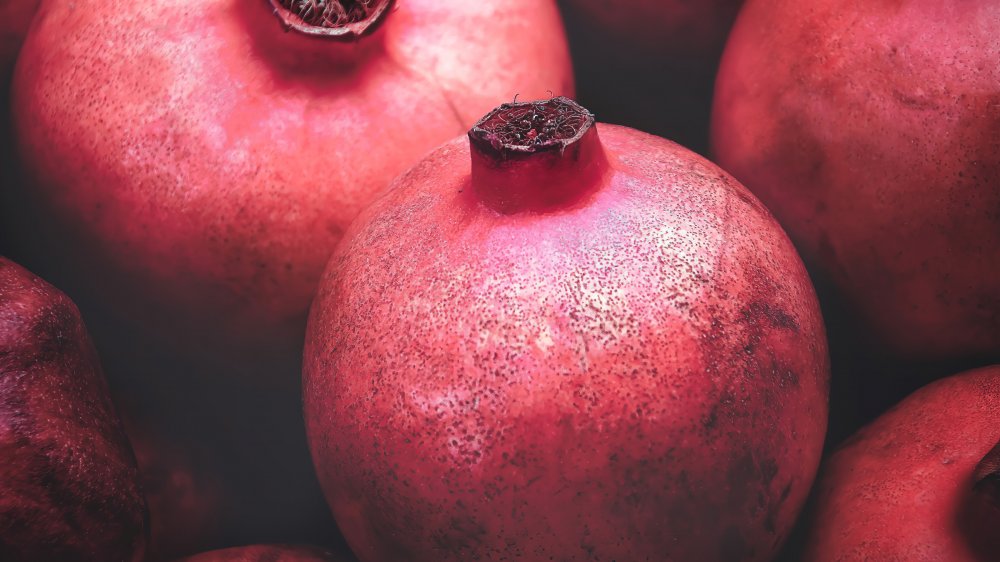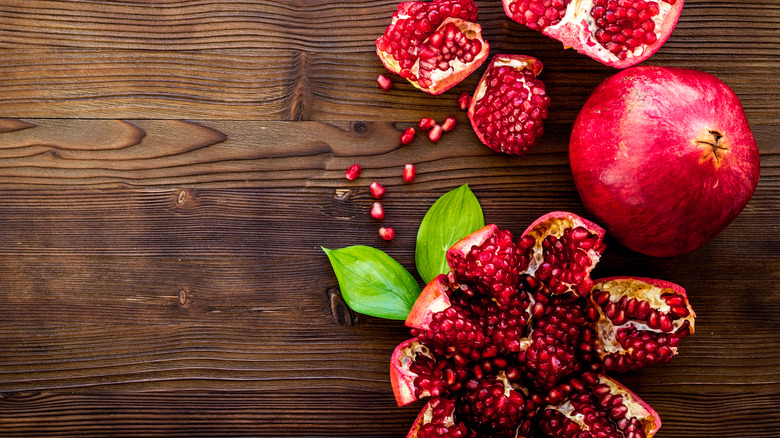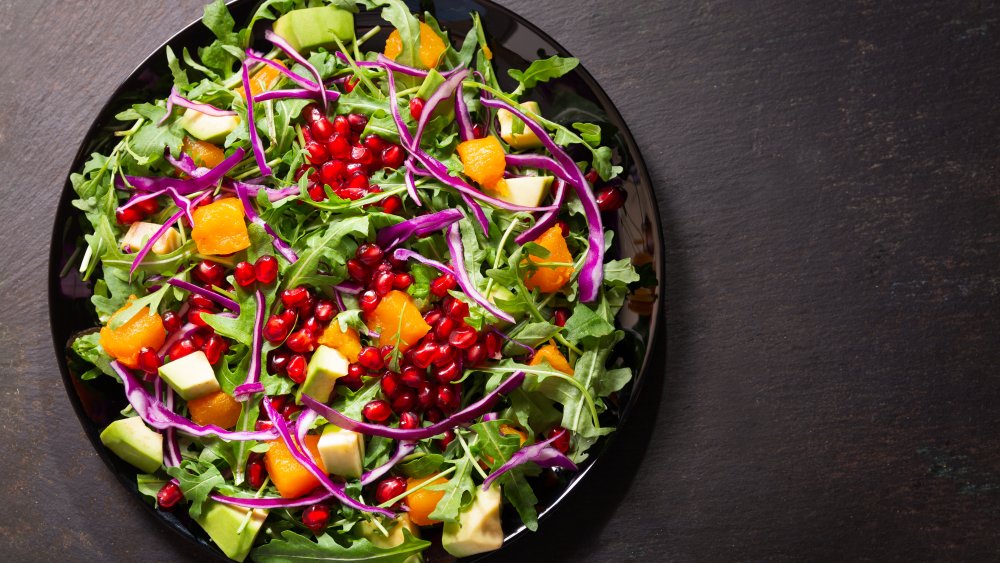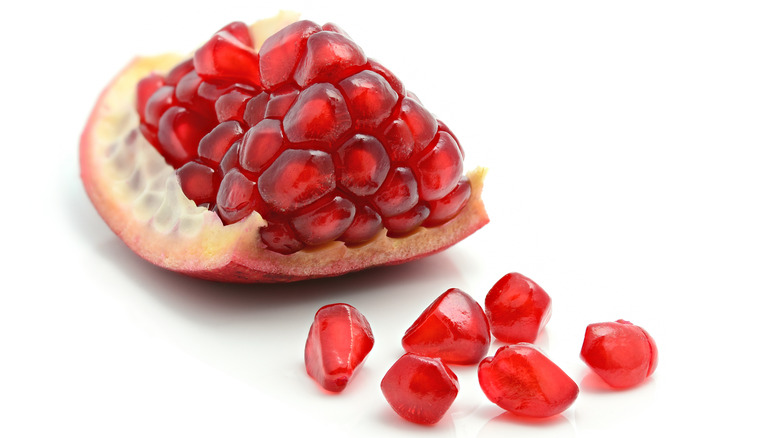What Are Pomegranates And How Do You Eat Them?
In recent years, the pomegranate (punica granatum) has gotten more and more popular on mainstream menus, to say the least. The fruit has wiggled its way into grain salads, smoothies, and stunningly colored cocktails. But its history spans back thousands of years. The Los Angeles Times notes the pomegranate is mentioned in multiple holy books, including the Koran and the Bible. In Ancient Greek mythology, the goddess Persephone was fated to spend six months of every year in the underworld after she ate half a dozen pomegranate seeds. And south of Naples, the Oplontis villa — a community still preserved beneath the ashes of Mount Vesuvius — features centuries-old frescoes of the deep red fruit, according to National Geographic.
So, yes. Before it became trendy enough to grace Bobby Flay's salad dressing, the pomegranate has led an interesting life. And the next time you bite into one of its taut, juicy seeds or sip its tart juice, you might benefit from knowing a bit more about the pomegranate shrub and its hard-to-resist fruit.
How to open a pomegranate
You'd likely be eating a whole lot more pomegranates if the task of opening up this fruit didn't seem so daunting. Luckily, there are hacks for opening a pomegranate to make the job as seamless as possible. POM Wonderful provides instructions for easy opening. First, you should cut off the pomegranate top, a half-inch down from the crown. Then, score the skin along each visible white membrane section that divides the arils (arils are the red seeds inside). Over a large bowl of water, you can start pulling the pomegranate apart. Pull the arils off of the pomegranate using your thumb, and the seeds will float to the bottom. You can toss the white membrane that floats to the top of the water. Once you're done separating the fruit from the peel, you can strain the bowl.
According to Chowhound, pomegranate is best between October and January, when it can be found at your local grocery store. You're looking for firm fruit with a deep red color.
How do you eat pomegranates?
Now that you finally know how to get those tiny seeds out of the fortress that is the pomegranate, what can you do with them? Pomegranate tastes a lot like citrus fruits, or cranberries, with their mix of sweet, tart, and musty taste (via Taste of Home). Those sweet, tart seeds are perfectly delicious on their own, of course, but there are many more options. You can create pomegranate juice using your blender, a juicer, or by crushing the seeds in a plastic bag. Once you have pomegranate juice, you can enjoy it as is, or add it to dressings, beverages, and sauces (via Chowhound).
Fall and winter are the perfect time to experiment with pomegranate recipes because the flavors blend so well with fall vegetables. Food & Wine suggests trying pomegranate molasses with oven-roasted squash, endive salad with kumquats and pomegranate arils, pearled barley salad with apples, pomegranate seeds, and pine nuts, or pomegranate-glazed roast pork. However you decide to use pomegranates this year, from savory to sweet, you'll agree that they're always worth those few extra moments of effort.
Nutritional information about pomegranates
In the marketing world, the words "pomegranate" and "antioxidants" are often thrown together — like "yogurt" and "probiotics," or "salmon" and "omega-3s." But what do those buzzwords actually mean for your health?
Antioxidants, according to Healthline, are molecules that can prevent free radicals from affecting your body. Free radicals are atoms that travel through the body, potentially causing cell damage or mutation. Certain activities — like smoking and chemical exposure — can heighten the production of free radicals in the body, creating a possible risk for cancer and other diseases (via Medical News Today). So antioxidants, which are particularly high in fruits and vegetables, may play a role in keeping your cells healthy and stable.
And when it comes to antioxidants, the pomegranate steals the show. It contains punicalagin — a particularly strong antioxidant — and its juice holds three times more antioxidants than green tea (via Healthline). As for other benefits, pomegranates also include vitamin C, potassium, and fiber. Many cultures, such as those in Persia, Greece, and China, even consider the humble pomegranate a symbol of life, joy, and fertility, according to Chowhound.
The power of pomegranate peels
Generally, for snacking, we might reach for pomegranate seeds — scooping them away from the peel as quickly as we can. (As we covered above: The New York Times actually suggests dunking the fruit into a bowl of water when you cut a pomegranate, to prevent its juice from shooting out and staining your clothes.)
But the exterior of the pomegranate has health benefits, too. According to Healthline, pomegranate peels are also packed with antioxidants. Research has suggested the peel may treat hyperpigmentation and potentially even acne when applied topically. Another study cited in Verywell Health shows an ointment created from the pomegranate peel helped to quickly heal wounds while fighting off potential bacteria, but more tests need to be conducted with human subjects.
Of course, if you can't find the time to grind your pomegranate peels into a powder (a likely possibility), try using them in your compost.




